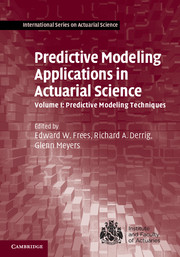Book contents
- Frontmatter
- Contents
- Contributor List
- Acknowledgments
- 1 Predictive Modeling in Actuarial Science
- II Predictive Modeling Foundations
- II Predictive Modeling Methods
- 7 Longitudinal and Panel Data Models
- 8 Linear Mixed Models
- 9 Credibility and Regression Modeling
- 10 Fat-Tailed Regression Models
- 11 Spatial Modeling
- 12 Unsupervised Learning
- III Bayesian and Mixed Modeling
- IV Longitudinal Modeling
- Index
- References
10 - Fat-Tailed Regression Models
from II - Predictive Modeling Methods
Published online by Cambridge University Press: 05 August 2014
- Frontmatter
- Contents
- Contributor List
- Acknowledgments
- 1 Predictive Modeling in Actuarial Science
- II Predictive Modeling Foundations
- II Predictive Modeling Methods
- 7 Longitudinal and Panel Data Models
- 8 Linear Mixed Models
- 9 Credibility and Regression Modeling
- 10 Fat-Tailed Regression Models
- 11 Spatial Modeling
- 12 Unsupervised Learning
- III Bayesian and Mixed Modeling
- IV Longitudinal Modeling
- Index
- References
Summary
Chapter Preview. In the actuarial context, fat-tailed phenomena are often observed where the probability of extreme events is higher than that implied by the normal distribution. The traditional regression, emphasizing the center of the distribution, might not be appropriate when dealing with data with fat-tailed properties. Overlooking the extreme values in the tail could lead to biased inference for rate-making and valuation. In response, this chapter discusses four fat-tailed regression techniques that fully use the information from the entire distribution: transformation, models based on the exponential family, models based on generalized distributions, and median regression.
Introduction
Insurance ratemaking is a classic actuarial problem in property-casualty insurance where actuaries determine the rates or premiums for insurance products. The primary goal in the ratemaking process is to precisely predict the expected claims cost which serves as the basis for pure premiums calculation. Regression techniques are useful in this process because future events are usually forecasted from past occurrence based on the statistical relationships between outcomes and explanatory variables. This is particularly true for personal lines of business where insurers usually possess large amount of information on policyholders that could be valuable predictors in the determination of mean cost.
The traditional mean regression, though focusing on the center of the distribution, relies on the normality of the response variable.
- Type
- Chapter
- Information
- Predictive Modeling Applications in Actuarial Science , pp. 236 - 259Publisher: Cambridge University PressPrint publication year: 2014
References
- 15
- Cited by

